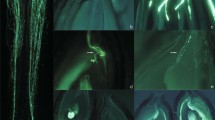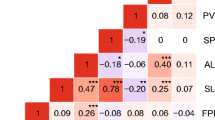Summary
The different viabilities of pollen produced at low temperatures in intra- and inter-specific crosses of tomato were studied. Cultivars Red Top, Moneymaker, and Marroqui were crossed with cultivar E-15 and these four cultivars were hybridized with lines of the wild speciesL. pimpinellifolium PE-13,L. parviflorum PE-52,L. pennellii PE-47, andL. hirsutum PE-37 and PE-41. A six-generation family of the Moneymaker x PE-47 cross was obtained to carry out a more detailed genetical study of pollen grain viability at low temperatures. Pollen grain viability was evaluated during the winter via acetocarmine staining. When the parents were compared with their F1, the intra-specific tomato crosses showed dominance to better-quality pollen, theL. esculentum x L. pimpinellifolium inter-specific crosses showed positive heterosis, while the crosses ofL. esculentum with the tolerant speciesL. pennellii andL. hirsutum showed intermediate inheritance. However, in theL. esculentum x L. pennellii family, the dominance and the non-allelic interactions (homozygosis x homozygosis) were the most important factors, so that dominance to better viability at low temperatures appeared to be the general mode of inheritance. Genetical control of pollen grain viability at low temperatures seemed to be polygenetic.
Similar content being viewed by others
References
De Verna, J.W., R.T. Chetelat & C.M. Rick, 1987. Cytogenetic, electrophoretic, and morphological analysis of progeny of sesquidiploidLycopersicon esculentum-Solanum lycopersicoides hybrids xL. pennellii. Biol. Zentl. bl. 106: 417–428.
Fernández-Muñoz, R. & J. Cuartero, 1991. Effects of temperature and irradiance on stigma exsertion, ovule viability and embryo development in tomato. J. Hort. Sci. 66: 395–401.
Fernández-Muñoz, R., J.J. González-Fernández & J. Cuartero, 1995. Variability of pollen tolerance to low temperatures in tomato and related wild species. J. Hort. Sci. 70: 41–49.
Hogenboom, N.G., 1972. Breaking breeding barriers inLycopersicon. 1. The genusLycopersicon, its breeding barriers and the importance of breaking these barriers. Euphytica 21: 221–227.
Maisonneuve, B. & J. Philouze, 1982. Action des basses températures nocturnes sur une collection variétale de tomate (Lycopersicon esculentum Mill.). II. Etude de la quantité et de la qualité du pollen. Agronomie 2: 453–458.
Mather, K. & J.L. Jinks, 1971. Biometrical genetics: the study of continuous variation. 2nd edn. Chapman & Hall Ltd., London.
Mutton, L., B.D. Patterson & V.O. Nguyen, 1987. Two stages of pollen development are particularly sensitive to low temperature. Tomato Genet. Coop. Rpt. 37: 56–57.
Patterson, B.D. & R.E. Paull, 1987. Hawaii as a natural phytotron for the introgression of cold resistance. Tomato Genet. Coop. Rpt. 37: 58–59.
Picken, A.J.F., 1984. A review of pollination and fruit set in the tomato (Lycopersicon esculentum Mill.). J. Hort. Sci. 59: 1–13.
Popova, D. & L. Mihailov, 1976. Studies on the qualities of pollen of F1 plants in heterotic tomato combinations. Genet. Agr. 30: 335–342.
Author information
Authors and Affiliations
Rights and permissions
About this article
Cite this article
Fernández-Muñoz, R., González-Fernández, J.J. & Cuartero, J. Genetics of the viability of pollen grain produced at low temperatures inLycopersicon Mill.. Euphytica 84, 139–144 (1995). https://doi.org/10.1007/BF01677952
Received:
Accepted:
Issue Date:
DOI: https://doi.org/10.1007/BF01677952




